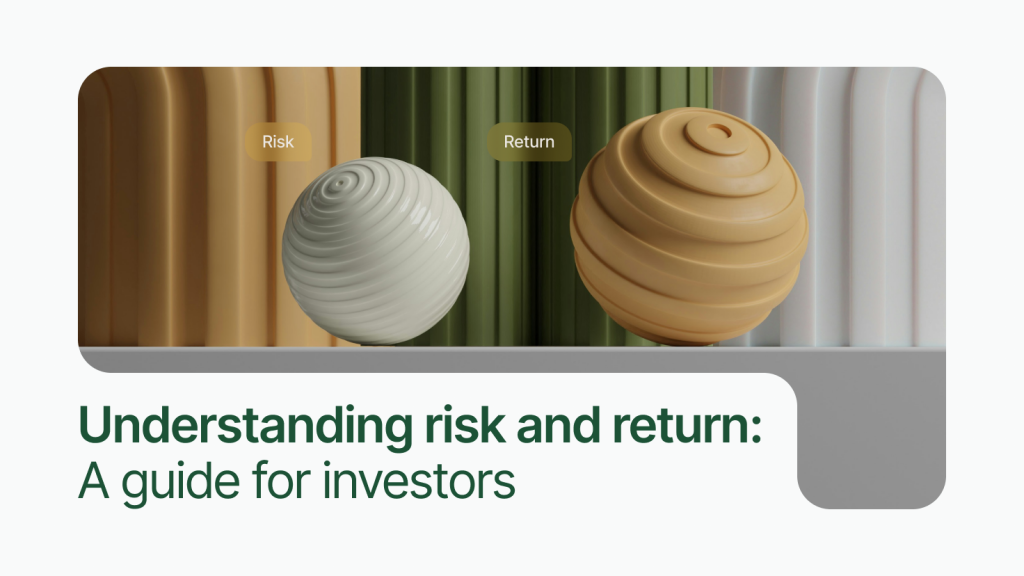As the investment landscape evolves, new trends, asset classes, and a changing macroeconomic environment alter traditional investing norms. So when it comes to achieving investment goals, the balance between risk and return has become a critical consideration.
With new trends, emerging asset classes, and fluctuating economic conditions, traditional norms for managing risk and maximizing returns are evolving. To make smart investment decisions, we suggest investors familiarize themselves with risk and return in investments. This article offers a detailed look at various asset classes to explain the risk-return tradeoff and help investors manage risk in investing, particularly in 2025’s unique market environment.
For those looking to build a diversified portfolio, understanding how to calculate risk and return can be a game-changer. By gaining insight into high-risk, high-return investments versus low-risk, low-return investments, investors can better match their financial goals with their risk tolerance.
To deepen your knowledge, read our guide on risk diversification and learn more about the Mintos approach to managing risk and return in investment portfolios.
Risk and return in income-producing assets
Stocks (Equities)
Stocks continue to be a go-to asset class for global investors. With above-average returns and multiple exchanges valued in the trillions, this asset class has stood the test of time, making stocks a strong example of high-risk, high-return investments within investment portfolios.
Can past performance predict future returns?
While past performance is often referenced in evaluating stocks, it has both its strengths and limitations. Looking at historical data helps capture patterns across economic cycles, offering a reasonably accurate picture of how stocks might perform under similar conditions. Research also suggests that stocks priced lower relative to their earnings tend to achieve higher future returns.
However, relying too heavily on historical data has its drawbacks. Over longer periods, shifts in economic conditions, changes in accounting standards, and evolving market dynamics can all impact the accuracy of predictions.
What are the factors influencing stock returns?
While various business and sector-specific factors influence stock returns, some broader economic, inflationary, regulatory, and rating factors also play a significant role. These assume that investors act rationally—taking only systematic and market risks into account. In reality, investor behavior can be unpredictable, and sentiment significantly impacts returns.
For more on balancing risk and return in your investment strategy, see our article on investment strategies.
Real estate
Real estate remains a popular choice for diversifying investment portfolios because of its ability to hedge risk. Not only against other asset classes like stocks and bonds but also against broader economic risks, including inflation.
Returns have varied significantly year-on-year, highlighting real estate’s risk-return tradeoff as both an income-producing and inflation-resistant asset class. For those seeking passive real estate investing strategies, balancing risk and return is key.
What factors influence real estate returns?
1. Market and regulatory factors: These include influences from global markets, local economic shifts, and changes in regulations.
2. Property-specific factors: These encompass physical, operational, and financial considerations tied to each property.
Understanding risk and return in real estate also means being aware of how unexpected costs—such as those from regulatory changes or information gaps regarding market fundamentals—can impact returns.
For passive real estate investors, these factors are especially important, as they can significantly affect both income stability and long-term growth.
How is climate change shaping real estate risk?
Real estate investments are susceptible to changes in the physical environment – something that’s evolving faster than ever before. From rising maintenance budgets to new costs related to sustainable energy requirements, environmental changes are rapidly altering the risk-return tradeoff in this asset class. Climate-related adjustments are becoming more costly, with some regions facing greater property risks than ever before. These trends are crucial for risk and return in investments as investors evaluate long-term real estate performance.
To dive deeper into passive real estate investing, see our guide on what is passive real estate investing.
Bonds
Bonds are a staple in diversified investment portfolios because of their historical stability and utility as risk-hedging assets. However, the dynamics of bond returns are evolving, with risk-adjusted returns impacted by inflation and economic shifts.
What factors influence bond returns?
Government bonds are generally seen as low-risk, low-return investments, often used to hedge risk in portfolios. Yet, rising inflation has put downward pressure on nominal bond returns, as they lack inflation protection. As inflation persists, the risk-return tradeoff becomes more pronounced, potentially reducing the benefits of traditional government bonds in diversified portfolios.
This situation has prompted some investors to turn to inflation-linked bonds, which offer more consistent returns during inflationary periods. Inflation-linked bonds may be especially valuable in today’s economic climate, as their risk-adjusted returns remain stable despite inflationary pressure.
Fractional Bonds on Mintos: A flexible alternative
At Mintos, investors have access to Fractional Bonds, an innovative form of bond investing that allows for participation in smaller portions of bonds. Unlike traditional bonds, Fractional Bonds make it easier for retail investors to gain exposure to bond returns without needing large capital outlays. These bonds are an efficient way to achieve low-risk, low-return investments while maintaining liquidity and flexibility.
How do Fractional Bonds work?
Fractional Bonds divide a larger bond into smaller, investable units, giving investors the option to buy fractions instead of the entire bond. This innovative setup lowers the entry barrier, enabling investors to diversify across multiple bonds with a modest investment. Fractional Bonds offer a straightforward way for investors to manage risk and return in investments by adjusting the size of their exposure to different bond issuers and types.
What are the benefits of fractional bonds?
1. Affordability: Fractional Bonds make it possible to participate in bond markets without the large financial outlay typically required, allowing investors to diversify across multiple bonds even with limited capital.
2. Liquidity and flexibility: Unlike traditional bonds, which often need to be held until maturity, Fractional Bonds on Mintos provide greater liquidity, giving investors the flexibility to adjust or access their investments as needed.
3. Enhanced diversification: Smaller portions of bonds allow investors to spread capital across various bonds, which can reduce portfolio risk. This enhances the risk-return tradeoff for investors aiming to stabilize their returns.
How Fractional Bonds fit into a diversified investment strategy
For investors seeking stability, Fractional Bonds provide a solid foundation in low-risk, low-return investments. They can serve as a stabilizing force in a diversified portfolio, complementing higher-yielding or more volatile assets like equities. Fractional Bonds also offer an efficient way to manage risk vs. return by balancing steady income with the flexibility to diversify across multiple bonds or bond types.
To explore Fractional Bond options on Mintos, read our guide on bonds, which details how these assets can help you diversify and manage risk vs. return effectively.
Investing in Loans
Alternative income-producing assets, like loans, have become increasingly popular among investors seeking higher returns. Traditionally, the loan investment market was limited to banks and large institutions. However, thanks to platforms like Mintos, retail investors worldwide now have access to loan investments, opening up new possibilities for risk and return for beginners, as well as seasoned investors.
On Mintos, investors benefit from the unique advantages of loans as an asset class, particularly through Mintos’ convenient access to diversified loans across multiple regions and borrower profiles. Loan investments offer a steady income stream and add diversification to portfolios by improving risk vs. return dynamics.
What factors influence returns on loan investments?
Like most investments, investing in loans involves some level of risk. Here are the main factors that influence loan investment returns:
1. Loan-specific risks: Sometimes, borrowers may miss payments or repay loans early, which can reduce investor returns. In cases of borrower default, a lending company might not recover the entire amount owed, impacting repayments.
2. Lending company-specific risks: The financial health of lending companies directly affects loan investments. A lending company may face operational challenges or even bankruptcy, which can impact its ability to meet obligations such as buybacks or timely payments to investors.
3. Regulatory and compliance risks: Lending companies and loan marketplaces operate under country-specific laws and regulations. Changes in these standards can impact business operations and, in turn, investor returns.
How do loan investments fit into a diversified portfolio?
For those building a diversified portfolio, loan investments offer a compelling example of the risk-return tradeoff. Loans tend to have a low correlation with other asset classes like stocks and bonds, helping investors achieve a more balanced risk and return in investment portfolios. On Mintos, many lending companies offer a 60-day buyback obligation, providing an additional layer of security for investors by helping to mitigate some common risks in loan investing.
With these unique attributes, loan investments are a valuable addition for beginners and experienced investors alike, serving as examples of risk and return in investing through varying levels of risk and potential return.
To learn more about the Mintos approach and start exploring loan investments as part of your investment strategy, see our article on how to invest in loans.
Choose Mintos for your investment journey
Mintos empowers investors to access a wide range of assets, making it easier to tailor a portfolio that matches individual risk tolerance and return expectations. For beginners new to risk and return, or investors seeking portfolio enhancement, Mintos offers a streamlined platform with tools designed for both simplicity and customization.
Investors on Mintos can benefit from diversified, income-generating options across global markets, alongside a variety of automated investing features. These tools help minimize the hassle of managing each investment and support a hands-off approach to passive income generation, a valuable choice for those balancing other commitments.
If you’re aiming to build a portfolio that performs well in the current market environment, Mintos can help you achieve this by offering resources and insights, including guides on setting financial goals, a long-term investments guide, and low-risk investments. Mintos makes it easy to approach risk and return in 2025 with confidence, drawing from our data-driven insights, real-time market updates, and extensive educational materials.
Ready to get started? Explore investment options on Mintos today and begin building a portfolio that aligns with your financial goals and helps you achieve a balanced approach to risk and return.
Want to learn more?
Disclaimer:
This is a marketing communication and in no way should be viewed as investment research, investment advice, or recommendation to invest. The value of your investment can go up as well as down. Past performance of financial instruments does not guarantee future returns. Investing in financial instruments involves risk; before investing, consider your knowledge, experience, financial situation, and investment objectives.

